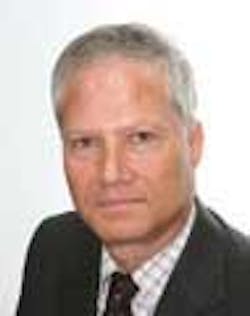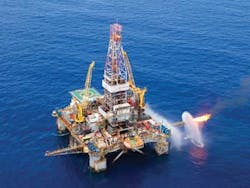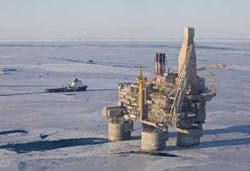More than 170 ultra-deepwater rigs were active in January according to analyst Douglas-Westwood, only slightly down on the corresponding total for early 2014. Average day rates rose by more than $15,000 to $485,465, mainly as a result of contracts signed before the oil price dip. Many more wells could be drilled this year if the price recovers to $50-$70/bbl, the analyst adds, with the number of deepwater wells potentially rising by 32% by 2020.
North Atlantic
Statoil handed back four of its exploration licenses offshore Greenland although it has retained block 6, which has a longer deadline for drilling. The company based its decision on analysis of production potential and the costs of operating in the area.
Brazil
Petrobras says it has saved around $1 billion since the start of its Well Cost Reduction Program (PRC-Poco) in 2013. This takes in various initiatives including use of simpler, lower-cost vessels to replace drilling rigs for certain activities; simplifying designs for multiple sets of wells; and raising the efficiency and availability of the company's fleet of floating rigs for constructing and maintaining wells.
Consultant Petrodata reports that Petrobras also now operates more floating production platforms than any competitor worldwide. In December it operated 110 facilities off Brazil, including 45 floating platforms, 15 semisubmersibles, and one non-storage production vessel, the P-53. Collectively these platforms produced on average 2 MMb/d of oil and 51 MMcm/d of gas.
The semisubmersibleOlinda Star was due to side track the recently drilled Kangaroo-2 appraisal well in block S-M-1165 in the Santos basin. According to operator Karoon Gas, drilling confirmed a 250-m (820-ft) gross oil column in Paleocene and Maastrichtian reservoirs, with tests suggesting a vertical production well could deliver up to 8,000 b/d. Karoon planned two side tracks targeting the same reservoirs at downdip and updip locations along with potential hydrocarbons in the Campanian. The results will assist assessment of the Kangaroo field's commerciality.
West Africa
Repsol has completed an exploratory well 60 km (37 mi) from Lanzarote and Fuerteventura in the Canary Islands. The drillship Rowan Renaissance drilled the well over a two-month period in 882 m (2,893 ft) of water, to a TD of 3,093 m (10,147 ft). Samples contained gas, but the quality and volume was sub-commercial and within thin, non-exploitable layers. The company said it planned no further activity in the area.
Petroleum Consultant ERC Equipoise has upgraded prospective resources in African Petroleum's (AP) four licenses offshore Liberia and Côte d'Ivoire. The latest audit took into account eight newly identified Turonian and Cenomanian prospects and information from other nearby drilling campaigns in 2014, notably Total's CI-514 oil discovery last April. ERC has increased by 33% the resource potential at AP's Liberian LB-08 and LB-09 concessions to 5.854 Bbbl (unrisked and risked). At Côte d'Ivoire licenses CI-513 and CI-509, the resource has risen 118% to 2.586 Bbbl.
Eni and partners Vitol and GNPC have signed an agreement to deliver the Offshore Cape Three Points project in Ghana. This will be a deepwater development, 60 km (37 mi) from the coast, with peak production of 80,000 boe/d. First oil is slated for 2017, followed by first gas one year later. Two Yinson subsidiaries will supply and operate an FPSO for a firm period of 15 years, under a contract valued at up to $2.54 billion.
Lekoil has opted to develop the Otakipo field offshore Nigeria in two phases following a revision of the proved and possible resources by AGR TRACS International. Phase 1, targeting a potential 23 MMbbl, will involve recompletions of two wells and installation of a 6,000-b/d capacity early production system. The program could get under way by mid-year. Phase 2 calls for incremental development of the rest of the field via a central processing facility and seven wells. The field is in the eastern Niger Delta region.
Angola's government has extended the exploration period for deepwater block 15/06 where Eni recently started production from the West Hub complex. The East Hub, currently under development, is expected to come onstream in 2017. Eni requested more time for a three-year program that includes three exploration wells and 1,000 sq km (386 sq mi) of new 3D seismic. The extension also applies to an area adjacent to the block that contains the 100-MMbbl Reco-Reco oil discovery.
Black Sea/Caspian Sea
Gazprom was due to call for tenders for front-end engineering and design (FEED) for a new gas pipeline across the Black Sea to Turkey. The company said 660 km (410 mi) of the route, which will have four pipeline strings, will be within the corridor of the shelved South Stream project.
Currently the goal is to land first gas in Turkey in December 2016, with the first string's 15.75-bcm capacity reserved exclusively for Turkish customers.
Wood Mackenzie expects Caspian Sea operators to favor low-cost exploration this year, although there will be some higher-impact activity. One instance is the newly signed shallow-water Absheron contract area in the Azeri sector where BP and SOCAR are due to acquire 2D seismic.
The analyst also foresees gas production from BP's Shah Deniz field off Azerbaijan climbing to 1,040 MMcf/d following debottlenecking of the onshore Sangachal plant, while replacement of the leaking pipeline serving the Kashagan field should get under way in the Kazakh offshore sector.
In the Iranian part of the Caspian Sea, North Drilling Co. has spudded a second appraisal well on the 2-Bbbl Sardar-e- Jangal discovery. Wells drilled to date could reportedly deliver 2-5,000 b/d.
North Africa
Eni subsidiary IEOC has signed agreements for two offshore blocks in Egypt's deepwater in the Mediterranean Sea. Both are west of the Shorouk block that the company acquired last year. The newly-awarded North Leil and Karawan concessions cover a total area of 9,670 sq km (3,733 sq mi). BP will partner with IEOC in Karawan.
Russia
Gazpromneft Sakhalin has been granted sub-soil rights to two license blocks off northern Russia. One is the potentially hydrocarbon-rich Severo-Zapadniy (northeast) block in the Pechora Sea, close to the company's producing Prirazlomnoye field, in water depths close to 200 m (656 ft). The Heysovskiy block is 1,000 km (621 mi) offshore in the Barents Sea, in water depths ranging from 200-500 m (656-1,640 ft). Northern parts of this virtually unexplored block are ice-bound most of the year – the limited data available includes 8,300 km (5,157 mi) of 2D seismic.
ExxonMobil has produced first oil from the Arkutun-Dagi field in the Sakhalin-1 concession, 25 km (15.5 mi) off the northeast coast of Sakhalin Island. The giant Berkut platform can handle production of 90,000 b/d at peak. Partner Rosneft says this is the world's most powerful drilling platform, capable of horizontal well displacements of 7 km (4.3 mi).
Asia/Pacific
McDermott International has completed installation of the 3,086-ton (4,871 metric ton)topsides for the central processing platform (CPP) at the Kepodang gas field offshore Java. The contractor achieved installation via the tight-slot floatover method for Petronas subsidiary PC Muriah. McDermott's scope included construction and installation of the CPP jacket and topsides, a wellhead platform, and a 1.7-mi (2.7-km) 10-in. infield flowline in water depths of up to 230 ft (70 m). The gas will likely head to the Tambak Lorok power plant in Semarang, central Java.
Woodside Petroleum aims to drill an exploratory well this fall offshore South Korea on block 8/6 1N in the deepwater Ulleung basin off the east coast. The block partners have been interpreting data from a 3D seismic survey over the concession.
Australasia
ConocoPhillips' latest appraisal well proved more gas in the Barossa discovery offshore Australia's Northern Territory, according to partner Santos. Barossa-3, the second of a three-well campaign, was drilled in the Bonaparte basin, 300 km (186 mi) north of Darwin and 9 km (5.6 mi) from the discovery well. Logs confirmed 104 m (341 ft) net pay over the Jurassic Elang formation sands, and analysis indicated an 18-19% carbon dioxide content. Santos said the gas could supply the Darwin LNG scheme. The partners have since spudded a further appraisal well.
Elsewhere in the basin, the first of two new subsea production wells has been completed for the Bayu-Undan Phase 3 development and drilling of the second is under way. Both will be tied into the existing platform facilities, Santos said, with first gas to follow later this year.
ThePolarcus Asima has started a large 3D multi-client seismic acquisition campaign offshore Western Australia. The area covered includes last year's unexpected Phoenix oil discovery, operated by Apache Corp. According to Carnarvon Petroleum, the Phoenix joint venture partners will license data from around 5,100 sq km (1,969 sq mi) covered by the survey. They plan to use it to assess future drilling prospects in the Phoenix area's primary Jurassic and Triassic reservoirs.
Origin Energy's Speculant-1 exploration well in the Otway basin has encountered potentially commercial gas. The well was drilled 3 km (1.8 mi) offshore the southern Victoria coastline, 30 km (18.6 mi) southeast of Warrnambool. The gas is in Waarre formation reservoirs.
Cooper Energy has agreed to acquire a 50% stake from Santos in the VIC/RL3 permit offshore southeast Australia and the associated onshore Orbost gas plant. The $27.5-million transaction is pending regulatory approval.
The concession includes the undeveloped Sole gas field, 65 km (40.4 mi) from the plant, which connects to the Eastern Gas pipeline serving markets in Victoria and New South Wales. Pre-FEED for Sole is expected to be completed next month, with the subsequent full FEED likely to stretch into 1Q 2016, followed by a final investment decision. The partners aim to start gas supplies from late 2018 or early 2019.
New Zealand Oil & Gas and Pan Pacific Petroleum have raised their assessment of recoverable oil in the Tui area in the offshore Taranaki basin by 2.4 MMbbl. This comprises 1.9 MMbbl from the Pateke-4H accumulation and 0.5 MMbbl from other Tui area fields following field life extension reviews. The Pateke-4H well should be tied into the FPSO Umuroa soon, coming onstream during 2Q. AWE is operator of the Tui joint venture.
About the Author
Jeremy Beckman
Editor, Europe
Jeremy Beckman has been Editor Europe, Offshore since 1992. Prior to joining Offshore he was a freelance journalist for eight years, working for a variety of electronics, computing and scientific journals in the UK. He regularly writes news columns on trends and events both in the NW Europe offshore region and globally. He also writes features on developments and technology in exploration and production.




